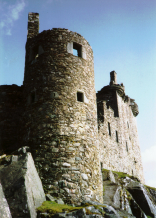Isobel Gowdie 1662
text from Scotland's Wicked Witches
Isobel Gowdie is one of the best-known cases from the witchcraft trials in Scotland, partly because her long and detailed confession is especially interesting and suggestive, but also because her case was used by later authors to construct an ancient and enduring pagan or demonic belief system, not least by Margaret Murray, although her idea of a fertility cult has been soundly criticised by many in recent years.
It was claimed that Isobel’s testimony confirmed what many now believe as Satanic practice – an inversion of Christian belief – such as a coven of thirteen witches, a renunciation of Christ with a Satanic baptism, copulation with the Devil, flying, shape shifting, controlling the weather, and murder by magical means, including using an effigy of the victim.
Isobel’s story has also inspired her inclusion as a character in several novels and songs, as well as an orchestral work by James MacMillan, called ‘The Confession of Isobel Gowdie’, premiered in 1990.
Isobel Gowdie originally resided in Auldearn, which lies a few miles east of Nairn in the north of Scotland. Some have described her as a beautiful, red-haired young housewife at the time of her prosecution, although in 1662 Isobel was certainly no longer young, especially for seventeenth-century Scotland.
Although it is not known when she was born, a commission for investigating Isobel was issued in July 1643, some nineteen years before her confessions in April and May of 1662. In her statements, she said that she only became involved in malefice after she was married, so it is likely by the time of her trial she was in her fifties.
The source for her being beautiful or red haired is not clear. Her name is recorded as Issobell in the documents of the time, and her surname can also be spelt ‘Goudie’.
Isobel was the daughter of a lawyer, and she was married to John Gilbert, a kirk elder and a tenant-farmer on the lands of Lochloy, about a mile or so to the north of Auldearn.
Married women in Scotland retained their maiden names, which is why she is known as Isobel Gowdie and not Isobel Gilbert.
The lands were rented from the local landowner, John Hay of Park and Lochloy. Isobel was of the middle order in Scottish society, and would have been relatively wealthy compared to many. That she was unhappy in her marriage, and generally with her life, seems apparent from her subsequent behaviour, whatever the truth of her statements.
When she met another local woman reputedly involved in witchcraft, Margaret Brodie, believed to be the daughter of the laird of Brodie and a gypsy woman, Isobel strayed – all according to her own testimony – into a life of devilry, deceit and wantonness.
On the road to Drumduan, a place half a mile to the south-west of Lochloy, Isobel encountered the Devil, according to her own testimony. To impress her and to seduce her into renouncing her Christian faith, the Devil predicted that the following day the fertile lands of Culbin, on the shores of the Moray Firth, would be inundated with sand during a storm, which they duly were, ruining the harvest.
Indeed, as the century proceeded, the encroachment of sand increasingly became a problem until virtually the whole estate was covered in dunes; today the highest sand dunes in Scotland are at Culbin. Isobel perhaps took this event as a sign of the Devil’s veracity and power.
Isobel then went to Auldearn Kirk, where she met the Devil again, as well as Margaret Brodie and more of his followers. She found the Devil standing at the reader's desk in the kirk, with a black book in his hand, and he then baptised her, using her own blood. This blood he had sucked out of a ‘Devil's’ mark on Isobel’s shoulder, spitting it into her hand and then sprinkling it over her head and making a symbol, baptising her under her new name, ‘Janet’. She described the Devil as being a ‘meikle, black, roch man’ (large, black, rough man) with cloven feet.
Isobel consummated her relationship with the Devil a little while later near Inshoch Castle (a mile or so to the south-east of Lochloy), and also described many other amorous encounters, including with the Devil in the form of a deer.
She described the Devil as having a member which was great and long, and that many of the younger women enjoyed sex with the Devil more than with their husbands. She explained that, while out on her diabolic and wanton escapades, she managed to deceive her husband into thinking she was still in bed with him, or had even accompanied him to church, by various means, including a shadow-self, a body-double, and turning herself into a jackdaw and slipping away.
Consequently her husband John Gilbert remained ignorant of her behaviour, which was fortunate for him as he might also have become involved in the accusation and shared her fate.
Isobel said that each witch had a spirit to look after them and carry out their will; her spirit was called the Red Reiver and was dressed in black. She reported that there were thirteen in their group or coven, that there was a male and a female leader, and that she became the head of the coven at the Devil’s command.
As well as at Auldearn, they also met at Hill of Earlseat and in the kirk of Nairn, and there were Grand Meetings at the end of each quarter year. She also told that the Devil beat them at their meetings, and that large sums of money given to them by Satan changed into horse dung within a day.
Isobel claimed that she and others could fly, and used this to get into people’s houses to steal food and drink. To fly, they needed to recite, ‘Horse and hattock, in the Devil’s name,’ with the straw between their feet. This has been interpreted by some as perhaps being a reference to a broomstick.
They could also change shape, taking the form of animals, such as a jackdaw (kea in her words), a cat or a hare. The incantation used to transform into a hare was:
I shall go into a hare,
With sorrow and such and meikle care;
And I shall go in the Devil's name,
Ay while I come home again.
(meikle = great)
To restore their usual form, the following would be said:
Hare, hare, God send thee care.
I am in a hare's likeness now,
But I shall be in a woman’s likeness even now.
They also stole milk from beasts, by passing a tether between the cow’s or sheep’s legs, as well as thieving ale by magical means, taking it for themselves; the spell could be reversed by removing the tether. Similarly they stole crops; however one of the spells employed was much less pleasant.
At the kirk of Nairn, Isobel reported, with others, taking the body of an unbaptised baby and chopping it up into small pieces and combining it with their own nail clippings, grain and kale. This they used to take the corn from a farmer, leaving only empty husks, and sharing the crop among themselves.
At another meeting, she and her coven took paddocks (toads), and yoked them together to plough a field, leaving the ground only capable of growing thistles and briars.
At a dye-house, they performed a ritual using a thread with three knots, to remove dye, turning what remained black. Nor was their thieving confined to land: they also purloined fishermen’s catches, taking the larger fish for their own, by repeating three times:
The fishers are gone to the sea,
And they will bring home fish to me;
They will bring them home in the boat,
But they shall get of them but the smaller sort.
They could also reputedly control the weather, and raised a wind using a spell using a cloth and a beetle in water.
Isobel also told of their use fairy darts or elf shot (what is now known to be prehistoric stone or flint arrow heads that were found in the area – and in many other parts of the country).
According to her, these could be used to kill a person when the victim was struck with elf shot, although the arrow head had to be flicked in a special way using the thumb. Isobel said that she had slain several men this way, although just for her own pleasure, giving the commission the names of her victims.
In her statement, she claimed that the Devil gave elves instructions on how to use and make elf shot, and that the soul of a victim went to heaven but the body remained on earth. Indeed, the elf shot was manufactured by small hump-backed elf boys. She also said they recited the following verse when using the elf shot:
I shoot yon man in the Devil’s name,
He shall no win heal hame!
And this shall always be true,
There shall not be a bit of him alive.
As well as the Devil, Isobel met the elves, going down into a huge chamber in the Downie Hills, where at a great gathering she met the Queen of the Fairies or Elfame, describing her as being dressed in brown and white, and the King, ‘a braw, well favoured man with a broad face’. There were great bulls with the elves, a sign of their evident fantastic wealth and prosperity.
More seriously, Isobel apparently had a dispute with John Hay of Lochloy and Park, the local laird and her landlord. Some have suggested that he made improper advances towards her and that he would not repair dilapidated buildings on her rented farm. Along with others, Isobel made a clay figure of Hay’s son, roasting it and baking it in a fire. She claimed she spoke the following verse:
In the Devil’s name,
We pour this water among this meal,
For long dwyning and ill health,
We put it into the fire,
That it may be burnt both stick and stour,
It shall be burnt with our will,
As any stickle upon a kill.
(dwyning = dwindling stour = ashes, dirt
stickle = stubble kill = kiln)
This was to slay Hay’s male children, who reportedly then died. When Hay’s wife had further boys these thrived for only six months or so before they too withered and died.
Henry Forbes, the local minister, was also reputedly put under a spell and was afflicted with a wasting disease, although he later recovered and was one of those in attendance when Isobel made her confessions.
Isobel made four statements in April and May of 1662 about her unsavoury behaviour, apparently without torture or force being used, although the truth of that can never been known.
Why she would have chosen to do such a thing under her own volition is not clear. This was at the height of the witchcraft accusations and prosecutions, and conviction would lead to her death and that of anyone implicated with her.
In the commission granted in 1643 it did state that Isobel should be healthy in mind and body and that no duress was to be used. She was taken into custody on 12 April 1662, and the statements were made from the next day before a commission of local lairds, ministers and men of the parish and were recorded by John Innes, a public notary.
As the commission was granted nearly nineteen years before, however, it must have been well known in the area about the accusations and about the suspicions surrounding Isobel Gowdie and her friends and contemporaries.
Her statements implicated the other twelve people in her coven, and eventually more than forty women and men were included in accusations (although these were mostly from the confession of another local woman, Janet Braidhead, who confessed at the same time as Isobel).
Isobel’s final fate, however, is not recorded, nor is that of her co-accused. If she had survived unscathed until after the trial, however, it is very likely that she was throttled and then her mortal remains were burnt, along with the other accused, and their ashes were scattered on unconsecrated ground.
© Martin Coventry 2017








